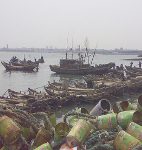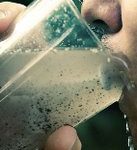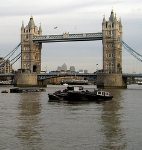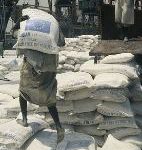Shan Haibing walks down to the sea and points at the water. “Have a close look,” he says. “Can you see any difference in colour between the sea here and other places?” The surface of the water is darker and has a reddish tinge.
“This is an outlet area. A factory buried its outlet pipe here.” According to Shan, the emissions reach their highest level in the afternoon. “When that happens, the water turns red. Every day is the same.” Shan describes how outlet pipes such as this – large enough for an adult to crawl into – are scattered all along the coastline.
Following the pipe a few kilometres towards its source, a huge chemical industrial zone looms into view. Wang Wenbin often drives past here. “This area contains the chemical industrial zones of Xiangshui County, Guannan County and Lianyungang [in Jiangsu province]. There are over 100 chemical companies here,” explains Wang.
“When they built the industrial zone,” says Chen Songfa, a 74-year-old resident of Duigou village, Guannan county, “there was a Communist Party meeting to discuss it. I’m a party member so I went along. We asked whether the new factories would affect the village, and the officials said ‘no’.” Now Chen sweeps the streets of the industrial zone – a job for which he is paid 5 yuan (US$0.70) per day.
“They lied to us about the effects on the village,” says Chen. “Now the Chao River runs red every day. There is nowhere for the public to take their complaints. They say that the factory has bribed all the party members.” What makes Chen even more furious is that when the locals complained about the pollution, he claims, the companies framed them for crimes they did not commit. Chen’s son, Zhaobing, was one of those affected.
“The villagers took samples from the river and sent them off to be tested,” Chen explains. “They found the water was poisonous and undrinkable for people or animals. They asked for 40,000 yuan (US$5,714) in compensation from the factories. But the management of the industrial zone sued the villagers for fraud.” As a result, some of the villagers were imprisoned for 6 months. Since then, they have not dared to put their anger into words.
It is not just Duigou’s villagers who have been jailed for their complaints. He Hongshi, party secretary of Touzeng village, near Yancheng, still has two years of a custodial sentence left to serve.
A villager from Touzeng, Zhou Lin, says: “He led the villagers in their attempts to stop the construction of the industrial zone. Now he’s doing time for the villagers.” Another resident, surnamed Li, who is planning to move house for the third time, goes down to inspect the open waste channel from the industrial zone. The channel is essentially a 10-metre-wide canal. “It runs for 10 kilometres from here to the sea,” says Li. He stops at a bridge near where the channel meets the sea. Below, the dying brown water slowly flows eastwards.
But these problems are not limited to northern Jiangsu. To the south, densely packed industrial zones run all the way along the coast from central Jiangsu to Zhejiang province. To the north, where Ganyu, in Jiangsu, stretches out towards the Jiaozhou Peninsula, in Shandong, the city of Qingdao is building the Huangdao Industrial Zone. Further north we find the Huanghua City industrial zone in Hebei. Even further north, Tianjin has an even larger petrochemical industrial zone, completing the chain of industry along the coastal northeast.
The trend for building industrial parks continues inexorably onwards, much like the flow of waste the factories emit into the sea. Enormous factories are under construction and the noisy machinery of existing plants disrupts the calm of the sea. This unbroken wall of noise stretches from Touzeng village near Yancheng, past Yanwei Port near Lianyungang, all the way up to the bay around Ganyu.
With all the pollution flowing from China’s rivers into its seas, killing fish and shellfish wherever it goes, can we still safely eat sea salt?
In December 2003, rumours started to spread around the cities of Xiamen and Fuzhou, in Fujian province, that sea salt was becoming inedible due to marine pollution. This caused the panic buying of older supplies of salt, which were thought to be clean.
In December 2006, the salt industry regulator in Shanwei, Guangdong, found the seawater that most of the city’s factories were using to extract salt was polluted with industrial and domestic waste. The salt produced was black and had high water content. It contained high levels of impurities and unsafe levels of trace elements. This meant it no longer met the national standard for “green foods”.
It is not only sea life that is poisoned when waste from the land enters the rivers and seas. Toxins are turning up on dinner tables through the salt extracted from sea water. Toxins may even end up back inside the bodies that produced them. Jiangsu Yinbao Salt Co., Ltd. owns several salt factories in places, including Xintan, Guandong and Touzeng, which neighbour the industrial zones of Lianyungang and Yancheng. The salt fields where sea water is evaporated lie next to the pollution-emitting factories. A worker at the salt factory in Xintan, surnamed Wang, admits: “We don’t eat the salt we produce.”
Zhou Wenchong, the villager from Duigou, Guannan county, Jiangsu (see part one), sends another text message: “What are we to do?” He is not the only one who is worried. Gao Zhiguo is head of the Maritime Development Stategy Research Insitute at China’s National Maritime Bureau. He is also a deputy to the National People’s Congress, and repeatedly urged the congress in 2007 to pass a regional law protecting the environment of the Bohai Gulf.
“The Bohai Gulf area is becoming one of China’s three big economic regions,” Gao says. He then lists his concerns. “The environment there is coming under unprecedented pressure. Severe pollution in some regions is rapidly spreading to others. In some parts, there has been a total breakdown of the local ecology. The fishing industry has virtually run out of resources. Ecological disasters such as red tides and oil slicks are frequent.”
According to Gao’s statistics, the Bohai Gulf is the most severely polluted area of sea in China. Every year 5.7 billion tonnes of toxic waste and 2 billion tonnes of solid waste are dumped into the gulf. Some seafood shops in Beijing and Tianjin have already stopped buying produce from such polluted areas. Of the 53 rivers which empty into the Bohai Sea, 43 are classified as severely polluted.
According to official Chinese statistics, the waters of the Bohai Sea contain around 2,000 times the normal level of heavy metals. There are no fish living within several nautical miles of the waste outlet pipes.
The National Maritime Bureau’s report on the state of the oceans in the first half of 2007 showed that emissions into the sea exceeding safe levels are increasing and show no sign of abating. Waters near to outlet pipes continue to deteriorate in quality; the need to reduce emissions is particularly apparent in the regions around the Bohai coast.
The Jiangsu Environmental Protection Bureau’s 2004 report on the state of coastal waters showed the area of polluted water had increased by 4,980 square kilometres on the previous year. The percentage of water that reached the top classification for water quality had plummeted, from 20% in 2003 to 4% the following year.
“The Bohai Sea has been dead for a long time,” says Gao Zhiguo, who hopes to bring it back to life through legislation. But many environmental experts estimate that it will take around 200 years to revive the Bohai Sea.
Meanwhile, the industrial parks continue to spring up around us, their rivers of black waste flowing towards the sea. There is every reason to believe that any of China’s seas could become the next Bohai.
This article first appeared in the Southern Metropolis Daily. It was planned by Yu Chen and coordinated by Yu Chen and Nan Xianghong. The authors were Yu Chen, Lu Bin, Yang Chuanmin, Long Zhi, Li Jun and Han Fudong. It is translated and reproduced here with permission.
Homepage photo by steven.buss



